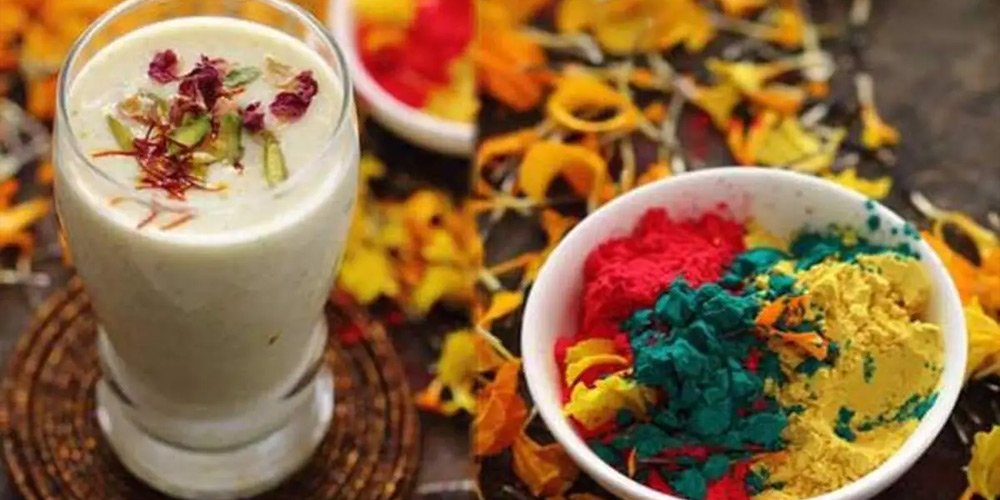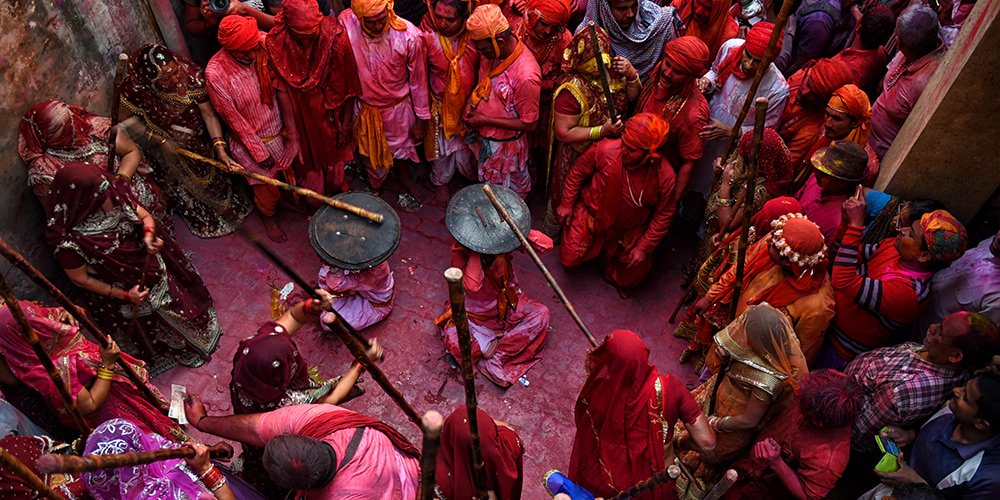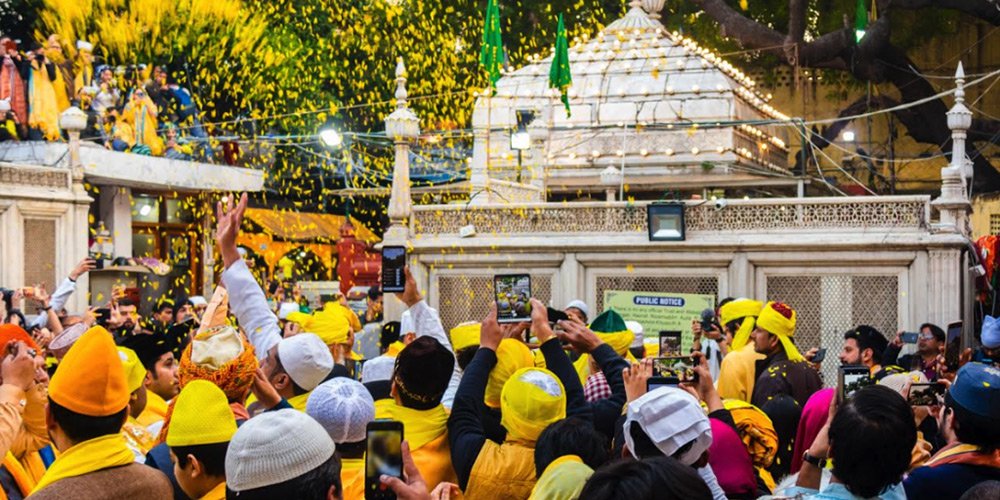Traveling to India around the time of the Holi festivities allows visitors to delve deep into one of the country’s most beloved festivals. There is no doubt that years after you have left India you will recall how it was to embrace that sheer joi de vivre of the Holi celebrations and how it enriched your life in many ways.
Celebrated in North India around the vernal equinox, the joyful festival is a vivacious explosion of the colors of spring, thanksgiving for the rejuvenation of the land after the long winter and the magic of gathering together with friends and family. What you will love about the festival is how communities and people set aside their difference and come together in the spirit of Holi.

The abandoned merriment, of dousing each other with colors of vibrant hues, of quaffing a glass or two of thandai (a milky drink of almonds, saffron, cardamom spiked with some cannabis), dancing to the sound of the dhol and traditional Holi songs–revs up the atmospherics around the table when everyone sits down to share a feast of a traditional Holi vegetarian meal.

Ladies, your journey from Delhi to Mumbai, which passes through Agra, Jaipur (and some of its surrounds), Jodhpur, Narlai and Ranakpur, offers some amazing moments of sightseeing, shopping, watching artisans at work and more. But enriching these experiences and learnings along the way will be those snatches of information about how Holi is celebrated by the places that you visit and the local communities you encounter.

Delhi–A tryst with history
You kick off your immersive introduction to Delhi with an up-close and personal exploration of Old and New Delhi. The 20-odd sites you will visit help you unpeel the multiple layers of this legendary city’s fascinating history, culture, and time-honored traditions. While New Delhi with its Vice Regal Palace, Parliament House and the Secretariat Buildings exhibits the picture of modern India, Old Delhi documents the most exciting chapters of the city’s past, in its palaces, mansions, elegant shrines, and colorful bazaars. High points of the tour include visits to the UNESCO-acclaimed World Heritage Sites such as the exquisite Humayun’s Tomb, the first garden tomb on the Indian subcontinent, and the Qutub Minar, the second tallest minaret in India.

Agra Meandrings
When traveling through Agra, you will love the viewings of the Taj from a different vantage point from across the Yamuna River. The location at sunset throws up great excellent photops of the iconic monument. Day 2 of your sojourn in Agra gives you exclusive time exploring the Taj Mahal at sunrise. The leisurely Colonial Walk, in fact shows the colonial face of this Mughal bastion through the lesser-known monuments and buildings by the British.

Jaipur Jaunts
Before heading for Jaipur, you will visit Emperor Akbar’s deserted capital of Fatehpur Sikri. Wandering around this red sandstone marvel unravels the mystery of why it was abandoned just a few years after it was built.
Post-lunch, you stop by at Abhaneri Village to gaze upon the stunning architectural marvel, the Chand Baori Stepwell, which represents Rajasthan’s ancient traditions of water conservation. At the Dera Mandawa Hotel, you will be hosted by its present custodian, the highly knowledgeable Thakur Durga Singh, for a special cooking lesson/dinner.
An excursion to Bagru Village next morning will introduce you to the unique art of block printing in this region as you watch the artisans at work. You can even create your own piece of block printing to take home. Post lunch, you will do a round of the iconic hotspots of Jaipur, including the City Palace, Jantar Mantar and Hawa Mahal. Ring down the night with an excellent dinner at the beautiful Samode Haveli. Next morning, you will visit Amber the old bastion of the Jaipur rulers. Back in Jaipur city, in the bustling bazaars of the Old Quarter, capture the rich nuances of the diverse crafting traditions of Rajasthan.

Jodhpur- ‘Blue City’ Musings
In Jodhpur, the legendary ‘Blue City’, guests can traipse around the bustling Sadar Market which stretches from the Sojati Gate to the Clock Tower. Amongst the plethora of items on sale, you will discover the city’s preparation for the Holi festivities…. On display are mounds of dry powders in various colors, gulal gota (water cannon bowls), water guns, and traditional Holi snacks and savories such as kanji vada and yummy sweets such as gujjia, a pastry with delicious stuffing.
Later, back at the hotel, after sunset you can participate in the Holika Dahan ceremony. This traditionally falls on a full moon night in the Hindu month of Phalguna. Atop the bonfire to be burned is an effigy of Holika, the demoness, who was burned to death with the help of Lord Vishnu. As the effigy of Holika goes up in flames, people sing and dance around the fire to celebrate the triumph of good over evil.
Next morning, dressed in traditional pristine white kurta pajama, join in the general merriment of playing Holi with floral petals and organic powder dyes. Soak up the rich atmospherics of the celebrations while joining in to shake a leg with everyone to the accompaniment of the nagada (drum). Later, indulge in a delicious Holi lunch, powered by lively camaraderie with other guests.

Narlai-Native Traditions
Visiting the 17th century Rawla Narlai Heritage Hotel, which once served as a holiday home for the Maharaja of Jodhpur, offers another opportunity to dip into the fun and folic of Holi celebrations. After a lovely lunch, you go down to the village to witness the post-Holi celebration, conducted with a great verve of folk songs and dances. A quick visit to Ranakpur brings you to the astonishing architectural marvel–the legendary 15th century Jain temple, remarkable for its stunning stone carving workmanship.
Mumbai- Millennium City Magic
The visit to Dharavi, once touted as one of Asia’s largest slums offers a fantastic socio-cultural experience. Discover for yourself how over the years it has transformed itself into a major economic hub for the community. Another exceptional interface with Maharashtra’s rich cultural offerings is through a workshop of Warli art. The Warils, the indigenous mountain people of the coastal area of the state, have an ancient and rich art heritage, which continues to be relevant to modern day Mumbai’s art scene. Uncover daily rhythms and routines of the city… be it amidst the fish market, the flower vendors, the spice shops, the newspaper sellers, or the milkmen on their daily run–or the iconic Dabbawallhas transporting hot meals to city offices. Wrap up your Mumbai sojourn with a lively Bollywood Dance Workshop and dinner with Michelin chef, Vineet Bhatia.


